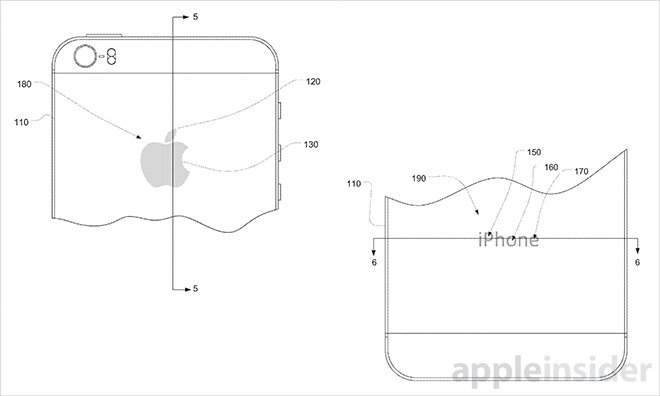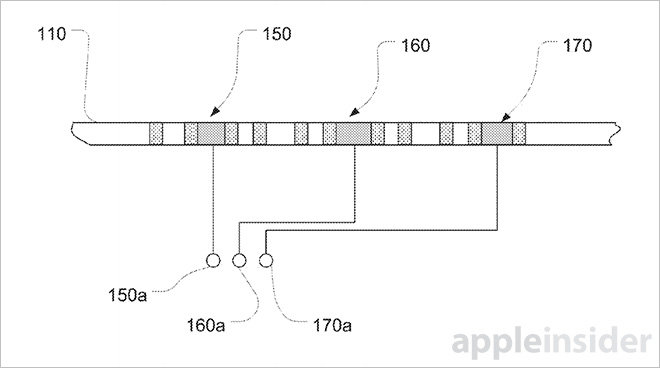In a seemingly never-ending quest to make thinner, lighter mobile devices, Apple is researching methods by which heart rate monitors, skin conductivity sensors and more can be directly incorporated into an iPhone's product logo.
Titled "Concealed electrical connectors," Apple's patent application filed with the U.S. Patent and Trademark office on Thursday details an electrical system that integrates with existing apertures or surface anomalies in a mobile device chassis, a good example being the Apple logo emblazoned on all iPhone and iPad models.
In some embodiments, electrically conductive inserts are embedded into one or more apertures within the device chassis. Certain designs call for concealment beneath existing marks, such as the "iPhone" product identifier, while others incorporate inserts made of materials that contrast with surrounding metal to enhance logo visibility.
Complete or partial glyphs, letters, words, numbers and other symbols may be used to conceal any number of contacts. In one example, the word "Phone" might hold anywhere from three to eight distinct, insulated connections disposed under each letter or in the counter of a letter (described as an areas enclosed within a letter's boundaries). Inserts can then be paired to complete electrical circuits.
As for sensors, the document mentions biometric monitoring apparatus such as skin conductivity sensors, heart rate monitors and fingerprint readers. More robust implementations may be used for charging and docking mechanisms, including contact solutions like MagSafe. An inductive charging setup like the system introduced with Apple Watch is a possibility, though Apple's patent fails to mention such designs.
Other embodiments imagine optical sensors disposed beneath transparent glyph sections, optically opaque radio frequency windows, multi-use applications and more.
As with any Apple patent, it is unclear if the technology described in today's filing will show up in a shipping product, but the company's current lineup is well suited to the task. With iPhone 6, for example, Apple moved from a polished rear logo to an embedded design filled with stainless steel. That amount of space is more than enough to deploy a host of biometric sensors, though multiples would likely require collocation over a wide area like the letters of an "iPhone" indicia.
Apple's multi-use iPhone logo patent application was first filed for in December 2013 and credits Nicholas V. King as its inventor.
 Mikey Campbell
Mikey Campbell








-m.jpg)






 Christine McKee
Christine McKee
 Marko Zivkovic
Marko Zivkovic
 Mike Wuerthele
Mike Wuerthele

 Amber Neely
Amber Neely
 Sponsored Content
Sponsored Content
 Wesley Hilliard
Wesley Hilliard










15 Comments
Call it an "iPhone logo" all you want - I see an Apple logo there. Oh, I see. The "iPhone" type is included. Okay. I'd specify that. Because I've simply never seen an "iPhone logo".
So anyone who uses a case on their iPhone (nearly everybody) will be screwed if this sees the light of day.
Being dreaming of the Apple logo on iMacs to have Touch ID for years - hopefully its part of the plan
So anyone who uses a case on their iPhone (nearly everybody) will be screwed if this sees the light of day.
That's what I thought when I read this, too. I doubt very much that Apple will do this, even if it is true that they are investigating it.
So anyone who uses a case on their iPhone (nearly everybody) will be screwed if this sees the light of day.
Not necessarily the case. If it is a requirement for electrical connection be made then we have a problem NASA. If it is something else like a non-visible optical sensor then many cases could work with that as well as RF emitter/antenna e.g., the iPhone 6 series went from the phones sides being multiple antennae to no discrete side pieces so they put stripes across the back that I'm sure many think were for aesthetics but are actually plastic embedded antennae.